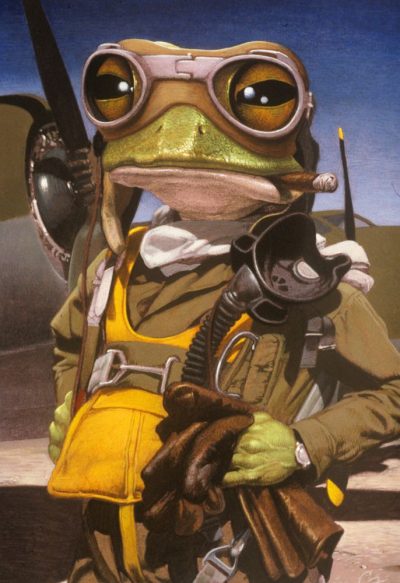 C.F. Payne is one of America’s great treasures. He has been at the forefront of magazine illustration for decades, along with creating advertising art, huge murals, postage stamps, album covers, and children’s books, and he spreads his knowledge far and wide with each new generation that sits in his classroom.
C.F. Payne is one of America’s great treasures. He has been at the forefront of magazine illustration for decades, along with creating advertising art, huge murals, postage stamps, album covers, and children’s books, and he spreads his knowledge far and wide with each new generation that sits in his classroom.
Payne’s unique observations on American life instantly give you the wistful warm and fuzzies that normally would come from pure nostalgia, even though these are his commentaries on our modern society. When he actually does purposefully wax nostalgic, such as with his incredible illustrations on the history of baseball, you can’t help but long for the days of peanuts and Cracker Jacks enjoyed from pine benches in an old fashioned ballpark.
Having been an admirer of his work for many years, what a treat it was to first meet C.F. back in 2001 when we both attended the National Cartoonists Society’s (NCS) Reuben Awards convention held in Boca Raton, Florida. While at first impressed with his talents, over the ensuing years I have come to equally appreciate his kindness and generous spirit.
Actually, just this past March, SILA was partnering with the LA Chapter of the NCS for a combined gathering together with C.F. Payne who was coming to Los Angeles with his Hartford Art School students. Unfortunately, the coronavirus hit LA with a vengeance and everything began to shut down about a week before the scheduled trip. So, perhaps this interview can somewhat take the place of what had promised to be a really fun evening.
This year’s entrants in SILA’s Illustration West 59 are fortunate to have C.F. Payne looking at their work as one of the judges. In advance of our October 31 deadline for entries, we hope you enjoy this look at the judge’s work.
Chad Frye
Illustration West 59 Show Chair
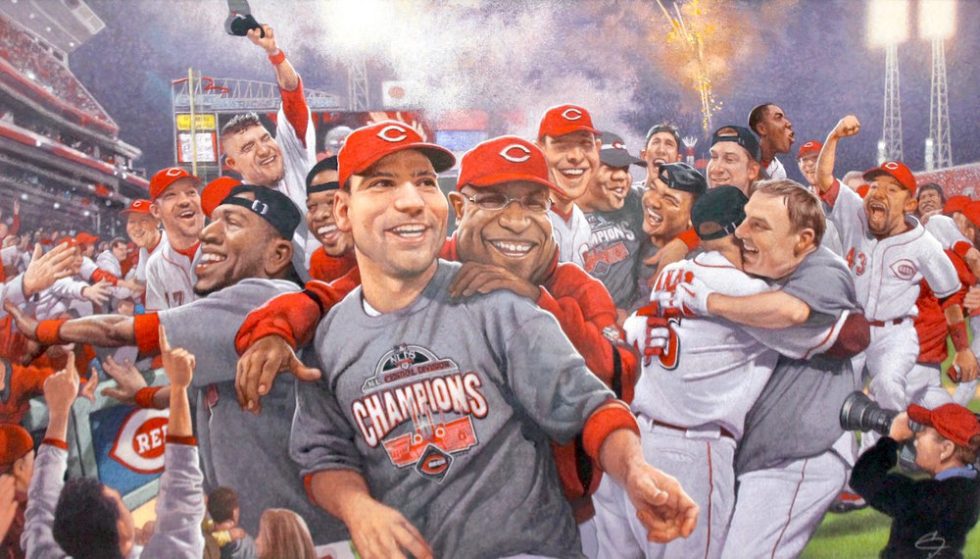
C.F., you have been a dominant presence in the world of illustration for many decades, and have had many opportunities creating work for magazines, books, postage stamps, music albums, etc., and your work has achieved great acclaim, and brought you some well deserved honors such as induction into the New York Society of Illustrators Hall of Fame in 2018. We all start somewhere, though. Do you remember your first professional illustration job – the first time someone paid you to draw?
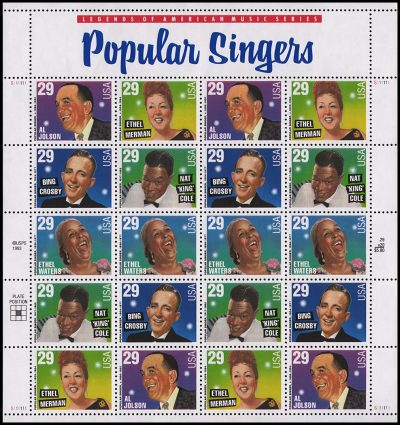 Yes, I do. My first job was as a studio artist for H&M, Arocom Advertising in Akron, Ohio.
Yes, I do. My first job was as a studio artist for H&M, Arocom Advertising in Akron, Ohio.
I had graduated from Miami University in June of 1976. Shortly after, I went to the Illustrators Workshop in Tarrytown, NY. The instructors were Mark English, Bernie Fuchs, Alan E. Cober, Robert Heindel, Fred Otnes and Bob Peak. I found out about the job opening while I was at the workshop. H&M, Arocom was the studio where Robert Heindel got his first job many years before. They were looking for a new artist following the departure of their studio illustrator. I drove from NY to Akron to show my portfolio of art and interviewed for the position. I was hired in October.
The first job they gave me was to create a duotone picture of an off-road vehicle driving in the mud with BF Goodrich tires. I think it was for a point of purchase brochure. As I recall, I had to do the picture two or three times before they reluctantly approved it. I had to ape the style of the previous illustrator. It took me some time to catch on, but slowly I was able to develop my own way of doing the art. It was a real learning experience for sure.
How about the first job of significance to you if that is different from your previous answer? That early job you were excited to get that maybe was when you thought that this was definitely going to be your career?
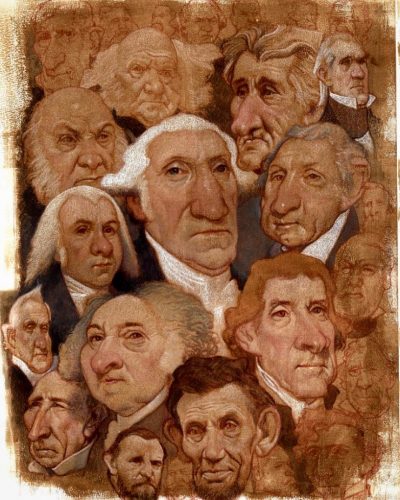 I started my freelance career in 1980 after my wife and I moved to Dallas, TX. That move was a game changer for me. The artists I met, the art directors who helped me with terrific assignments cannot be dismissed. I think the job that gave me a sense that I was going in the right direction was the first job I did for Fred Woodward who was art directing at D Magazine.
I started my freelance career in 1980 after my wife and I moved to Dallas, TX. That move was a game changer for me. The artists I met, the art directors who helped me with terrific assignments cannot be dismissed. I think the job that gave me a sense that I was going in the right direction was the first job I did for Fred Woodward who was art directing at D Magazine.
Prior to getting the assignment, I had made an appointment to show him my portfolio on the advice of many of the illustrators in the Dallas area. Fred, they all said, was a rising star. He was the guy you wanted to work for and please. Unfortunately, my first showing did not go well. My work clearly didn’t impress him. I knew then I had a problem.
After reviewing the art of some of the artists at what was then called Studio X, I realized my pictures were dated and stale. The advertising art I was doing in Akron, and then later in Chicago, was mostly created in a montage style. The Studio X artists were making pictures that had ideas with each artist having their own distinct style. For the next seven to eight months I took every job with the intent of creating pictures that had an idea or told a story. I created sample pictures to try different looks trying to find something that came natural to me and looked good. I finally decided to trust my own way of drawing and created pictures with the best ideas and design I could muster.
Eventually, I went back to D Magazine and Fred Woodward to show him my new work. The next week I got a call from Fred to create what be the first of many pictures I did for him for many years.
Many young artists looking to get into the business look at what you do with admiration, and they concentrate on creating beautiful art, but the business of illustration is exactly that – a business. Many art schools fail to teach the business side of being an illustrator. Might you have a tale of warning from your experience about the business side of things?
 I do think more schools, whether online or bricks & mortar, are waking up to the need for business for illustration to be part of their curriculum. I think it is due to the fact that many of the traditional markets for illustration are shrinking as new markets open new doors of opportunity. Included is the growing usage of online platforms for promotion that increases the individual artist’s ability to reach those new markets. All of this requires artists to be more entrepreneurial and take responsibility for their own businesses.
I do think more schools, whether online or bricks & mortar, are waking up to the need for business for illustration to be part of their curriculum. I think it is due to the fact that many of the traditional markets for illustration are shrinking as new markets open new doors of opportunity. Included is the growing usage of online platforms for promotion that increases the individual artist’s ability to reach those new markets. All of this requires artists to be more entrepreneurial and take responsibility for their own businesses.
If there is one thing I would caution young artists, it would be to first take off the rose-colored glasses you have about your own work. Be honest about your work, about the goals and markets you want to get your work. Are your really good enough to compete? Before you go out promoting your work, be sure it is really good enough. Promoting bad art is promoting your own failure.
Lastly, get to know a handful of good illustrators. Find the people in the business you can trust to give you honest advice. They don’t have to be big wigs, just solid performers whose advice you can trust. Learn from them. Don’t be a pest. Be a good friend and learn from them.

Your work for magazines is staggering in its prolific nature, and was how many people first became aware of what you do. Many pieces have had a bit of caricature in them, while maintaining the dignity of your subjects whether for Rolling Stone, Entertainment Weekly, or any 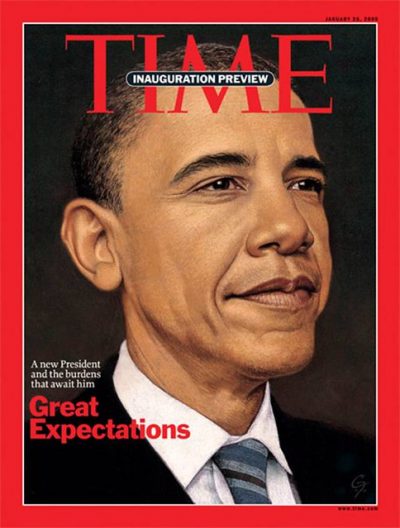 other number of publications. More unusual though is seeing your beautiful portrait work, and one of your best was that cover of TIME Magazine that you did of President Obama. Can you tell us a little about that job?
other number of publications. More unusual though is seeing your beautiful portrait work, and one of your best was that cover of TIME Magazine that you did of President Obama. Can you tell us a little about that job?
The Barack Obama TIME cover was commissioned by their art director, Arthur Hochstein. It was commissioned to compete for the Person of the Year cover. He specifically asked me not to do a caricature. He wanted me to work in the tradition of many TIME covers in the past done by artists like Boris Artzybasheff and Ernest Hamlin Baker. They sent me great photo reference. I asked that they compensate and get permission from the photographer. They did that. I got the assignment on a Thursday and the final art had to be in NYC by Monday. After the art was delivered, the editor chose the Shepard Fairey picture for the Person of the Year over my picture. It was very disappointing. Fortunately, a week or so later Arthur called me to inform me they decided to run my picture on the inaugural cover. I know Arthur fought for my picture to run in that issue. So, I was very grateful because it all worked out in the end.
Another piece that I find stunning is your caricature portrait of famed fine artist Andrew Wyeth, himself the son of illustrator N.C. Wyeth. Can you tell us how that piece came about?
The Andrew Wyeth portrait came about from a call from a curator from the Brandywine River Museum of Art. I was told, Betsy Wyeth wanted to buy a picture of Tom Petty I did for Entertainment Weekly to give to her husband, Andrew, as a gift. Unfortunately, I could 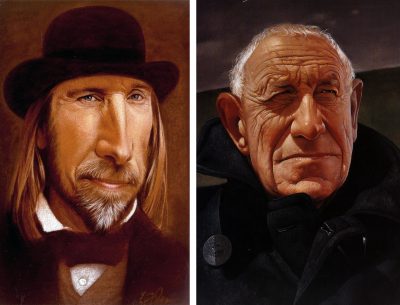 not because I had traded it away to a fellow illustrator and friend. She then asked if I would be willing to do a portrait of the great artist. I asked if she understood I did not do traditional realistic images. She told me that it was fine and it was the reason she asked. I was sent the photograph to use as reference.
not because I had traded it away to a fellow illustrator and friend. She then asked if I would be willing to do a portrait of the great artist. I asked if she understood I did not do traditional realistic images. She told me that it was fine and it was the reason she asked. I was sent the photograph to use as reference.
At the time I was teaching at Columbus College of Art & Design (CCAD), so I decided to use this assignment as a demonstration for my students. So, much of that picture was created in my class with the students watching. When, I was done, I sent the art out and was more apprehensive than any other time after completing a job. You always want your client to like your work. Having Andrew Wyeth as your client was different. I heard later he did like it and his first remarks were, “Are my ears really that big.” Later, I got a very nice hand-written letter from the great man.
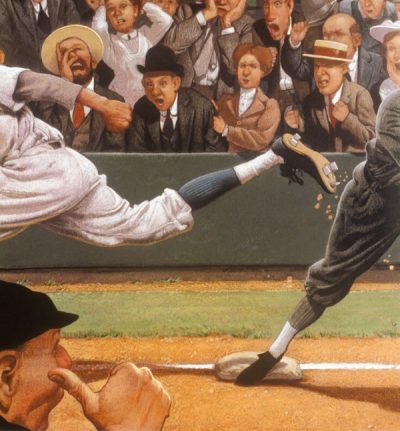 In more recent years, you have illustrated many children’s books. While still illustration, longer narrative art is definitely a different animal from the single editorial illustrations you had become known for. What led you to start working in children’s books?
In more recent years, you have illustrated many children’s books. While still illustration, longer narrative art is definitely a different animal from the single editorial illustrations you had become known for. What led you to start working in children’s books?
I got a call years ago to illustrate a children’s book. I was very reluctant because I knew it was a very different animal. I was very concerned because I was so used to the high intensity and short-term editorial assignment deadlines. I wasn’t sure I would do well with a long-term assignment with still so many editorial assignments coming in. Fortunately, the editor of my first book, Paula Wiseman, was very patient and helpful throughout the project. I learned a lot then. One thing I learned was how meaningful a children’s book could be. A children’s book lasts and is on a bookshelf for years. I liked that idea. As I got older, and the more teaching became more a part of my life, children’s books became a better fit. From time to time, I do get an occasional editorial assignment. I can’t take many of them. When I agree to accept them, they are fun and sometimes frustrating, but still high stress and short deadlines.

You have illustrated several books by celebrity authors over the years, too. Folks like John Lithgow, Steve Martin, and astronaut Mark Kelly. Might you happen to have any stories from possible interactions with authors such as this?
Not really. I have only met John Lithgow, who was very nice and very thoughtful. With the two books I did with John Lithgow, he did TV shows to promote the books. John was always very kind and gracious about giving me wonderful credit for the art. I know other artists who have not had that same luck.

You have also been a part of teaching new generations of artists with your continued participation in The Illustrators Workshop run by John English, Columbus College of Art & Design in Ohio, and now more recently you have been the Director of the MFA in Illustration Program at the Hartford Art School founded by illustrator Murray Tinkelman. Can you tell us a little about your interest in teaching?
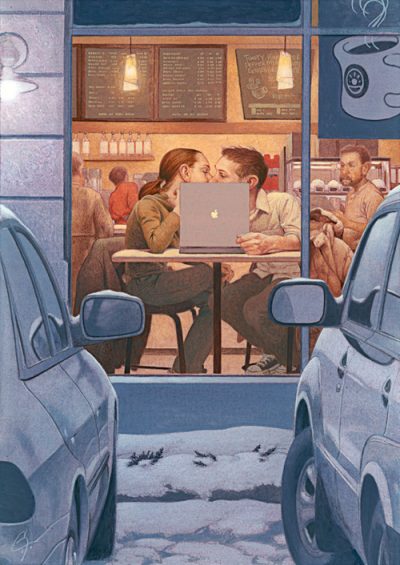 I have been teaching illustration for nearly thirty-five years. When I was first asked to teach illustration at Brookhaven College in Dallas, TX, I was solely focused on just trying to make it as an illustrator. I was an unknown illustrator at the time, and just trying to find my way. I do remember thinking how I enjoyed my learning experience, and felt if I could replicate that, I might do a good job. Later, I was asked to teach at East Texas State. I think it was there where I really gained confidence as a teacher because I saw the positive results students were making in their work. Since moving back to Ohio, I taught at CCAD for nineteen years before taking my position as director of the MFA in Illustration Program at the Hartford Art School.
I have been teaching illustration for nearly thirty-five years. When I was first asked to teach illustration at Brookhaven College in Dallas, TX, I was solely focused on just trying to make it as an illustrator. I was an unknown illustrator at the time, and just trying to find my way. I do remember thinking how I enjoyed my learning experience, and felt if I could replicate that, I might do a good job. Later, I was asked to teach at East Texas State. I think it was there where I really gained confidence as a teacher because I saw the positive results students were making in their work. Since moving back to Ohio, I taught at CCAD for nineteen years before taking my position as director of the MFA in Illustration Program at the Hartford Art School.
I have found that when you teach and see your students go out and have their own success, it is very rewarding. I have been lucky to work on big projects and win illustration awards, but seeing students go out and build their own lives, raise their own families through illustration, that is why I do it.
What’s next for C.F. Payne? Any new projects coming up that you can tell us about?
I have a few book projects that are in the maybe phase. We will see. But for now, due to the COVID-19 crisis, I have been so focused on the work of our MFA in Illustration Program. When I get time, I do try to make some pictures, but I have been avoiding assignments because of the time I need to focus on our students and the program.
Thanks for being a judge for Illustration West 59! We are looking forward to having you look at all the submissions this coming November!

Illustration West 59 just EXTENDED our Call for Entries to November 14, 2020. Submit today so that C. F. can see your work! Details can be found at IllustrationWest.org!
All artwork ©2020 C.F. Payne, not for re-use without permission of the artist.

